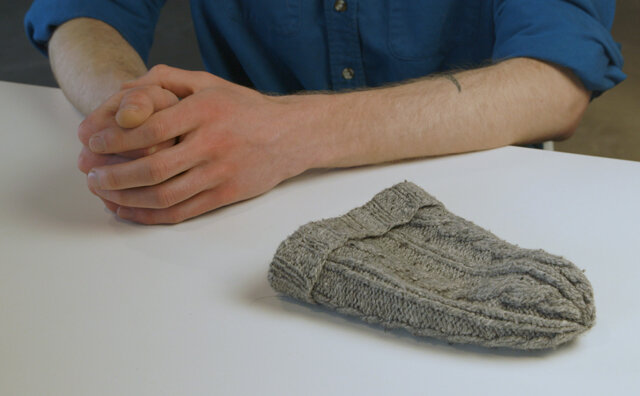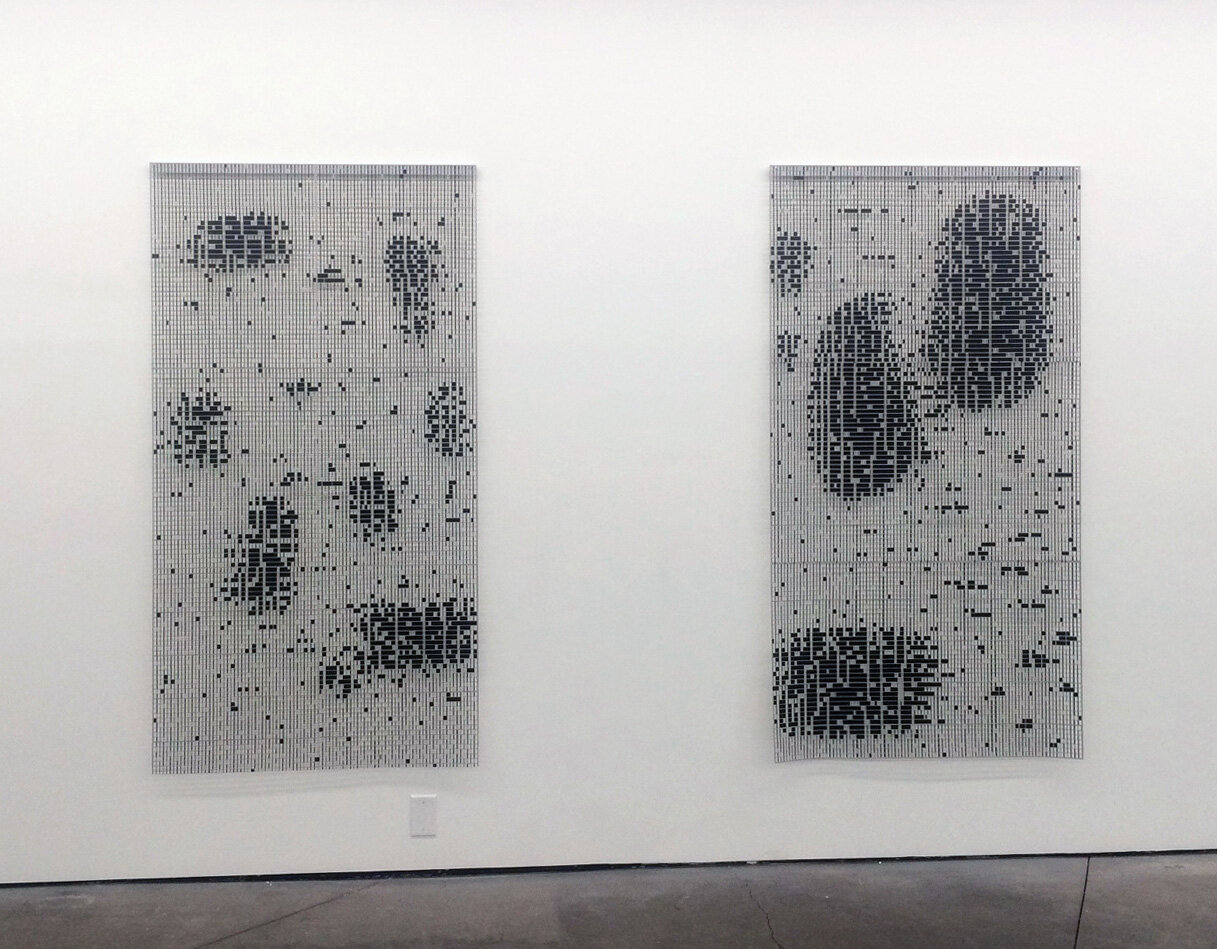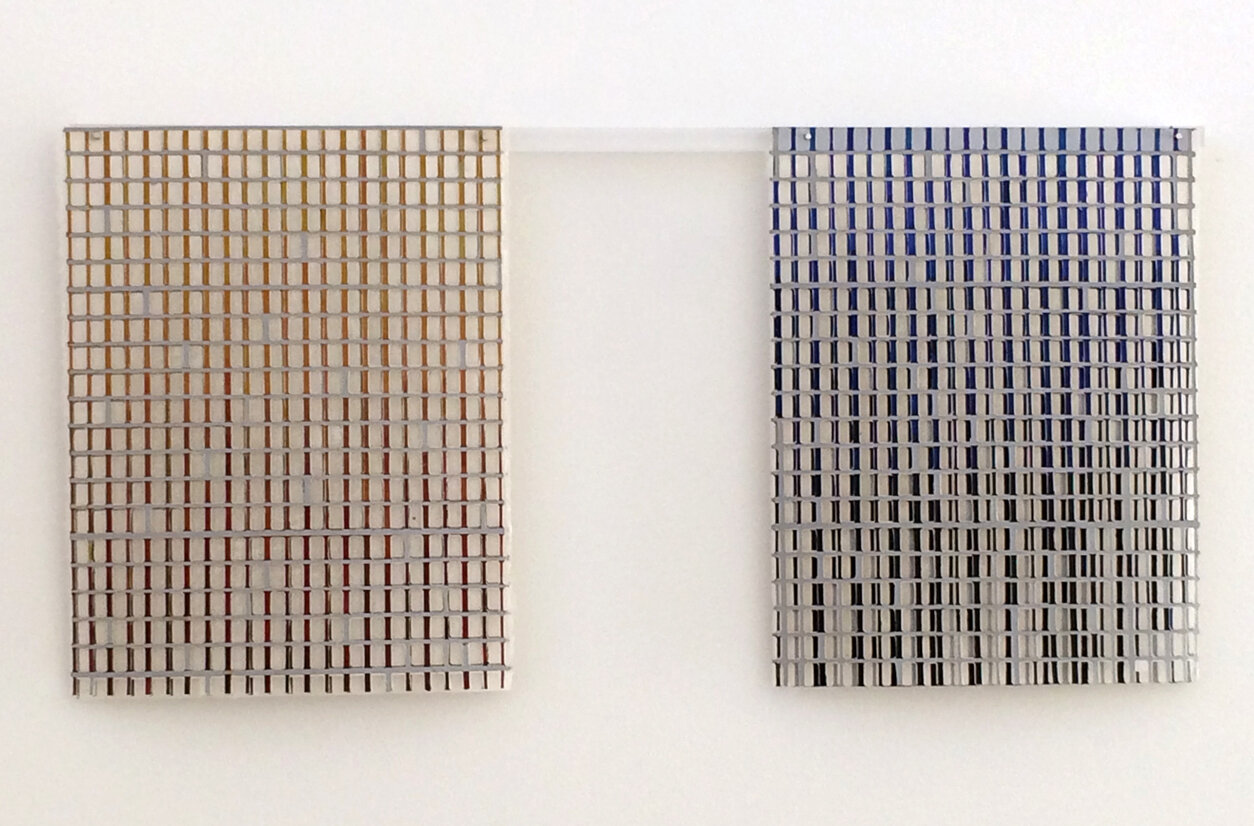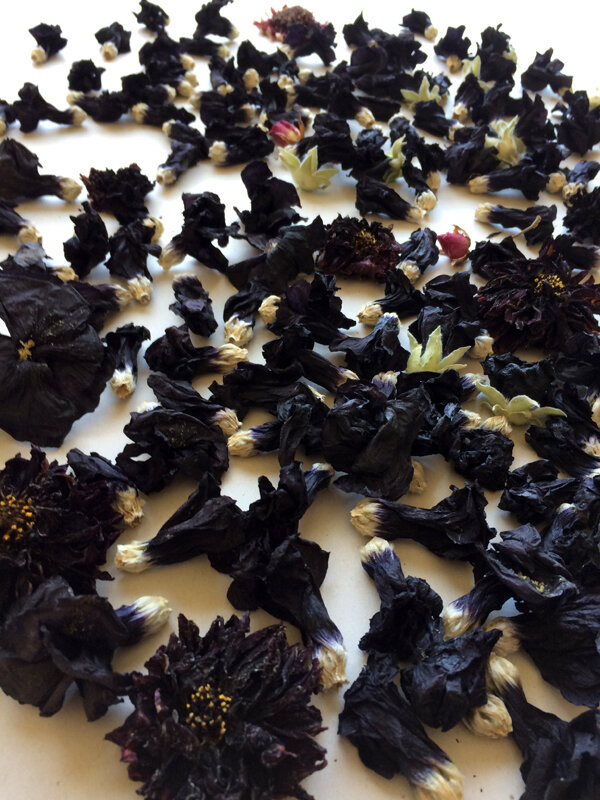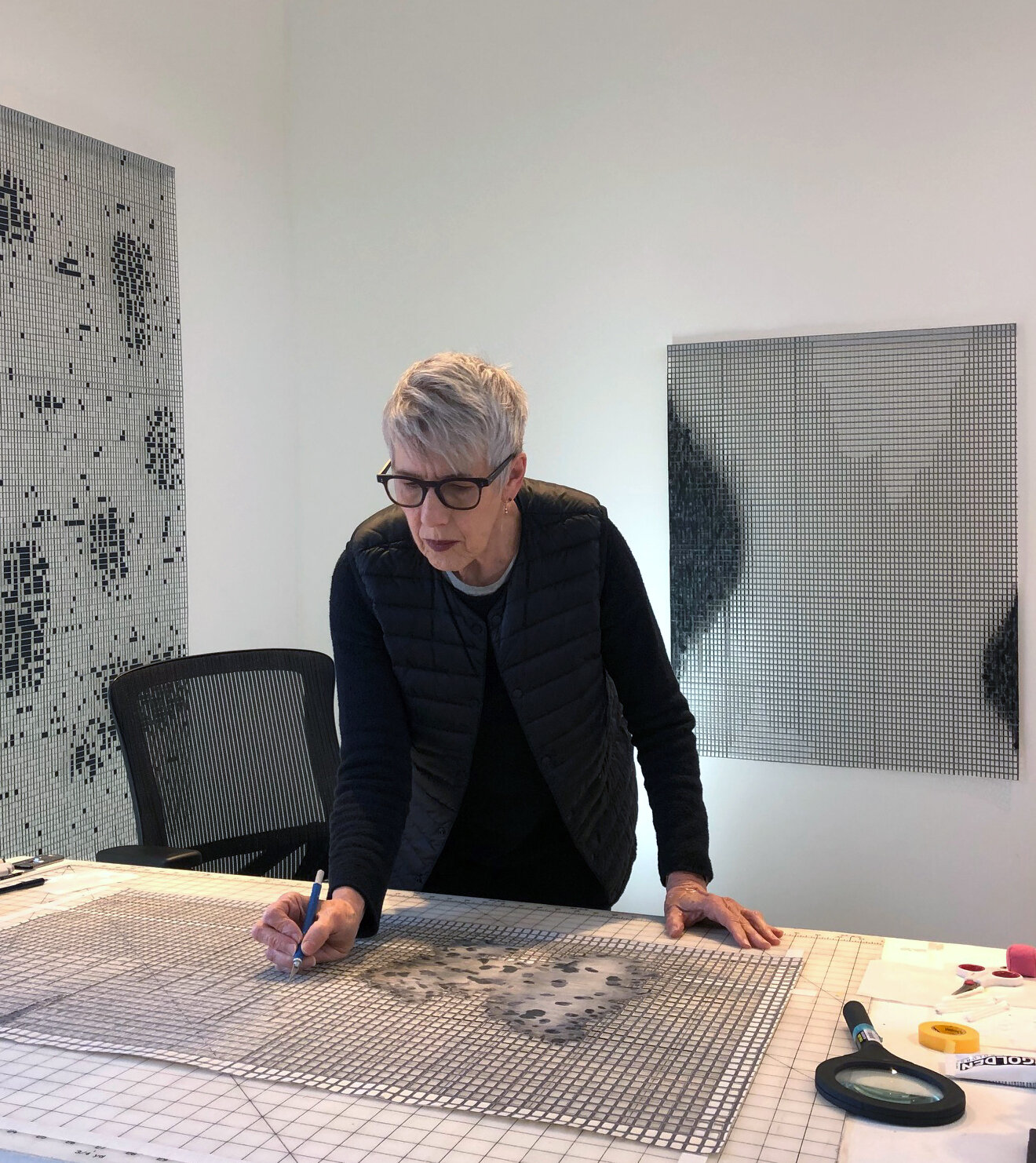Tactile materials provoke entry into conceptual subjects that circulate and resurface throughout Jane Lackey’s artwork. Her installations draw out participatory responses while abstract works on paper overlap textile references and drawing.
Exhibitions include The Art Gym, Marylhurst, Oregon; Tang Teaching Museum, Saratoga Springs, New York; New Mexico Museum of Art, Santa Fe; and Wellcome Trust, London. She has been awarded the US/Japan Creative Artist Exchange Fellowship, Camargo Foundation Fellowship and artist grants from the NEA and others. Lackey was Artist-In-Residence, Head of Fiber at Cranbrook Academy of Art and prior to that Professor, Kansas City Art Institute.
For more information, please see: http://www.janelackey.com, and on Instagram @lackeystudio.
Seat of Learning, Jane Lackey and Thomas Lehn, 2020, multimedia art installation, 32’ x 22’ x 9’, Marie Walsh Sharpe Gallery of Contemporary Art, Ent Center for the Arts, Colorado Springs, Colorado. Photo: Allison Danielle Moix
First, and most importantly, how are you doing? How are you navigating the highs and lows?
I feel fortunate to be well and to live a short distance away from Santa Fe where we built a house and studios just over two years ago. It’s a beautiful place to shelter during the pandemic and there’s plenty of work to do around our house and garden so it’s a good time to be focused on home. It takes all one’s strength to maintain compassion and equanimity these days. Taking walks in the high desert space and light of New Mexico helps smooth out the fluctuations.
Last January, I spent six weeks in Colorado Springs with my husband, a designer and artist, building a multimedia installation for the Marie Walsh Sharpe Gallery of Contemporary Art at the University of Colorado. It was a four-year long collaboration and finally we were putting together all the parts and content to be seen for the first time by both us and our audience. Seat of Learning, Jane Lackey and Thomas Lehn opened on February 27, 2020 with a wonderful reception and then was closed by mid-March. So disappointing, yet like many other exhibitions and artists in similar circumstances, it had to be. On September 1, the installation re-opened with limited numbers and by appointment through November 14, 2020.
Seat of Learning: Jane Lackey & Thomas Lehn, 2020, interior View. Photo: Allison Danielle Moix
Seat of Learning is a time-based, multimedia experience that examines intimate intersections between objects, memory and tacit understanding. A vintage school desk that we collected and lived with was the seed object for this project. Recognizing that people collect special objects that influence their lives and shape subconscious thoughts, we conducted over 70 video interviews about how and what individuals have learned from their objects. The resulting architectural installation and video narratives are seen through overlapping translucent walls that reveal each object and its recorded story as a sequential progression. Both a space to view from without and within, it causes visitors to walk slowly and listen as objects and voices provoke memory, self-reflection or discovery.
Seat of Learning: Jane Lackey & Thomas Lehn, 2020, Vintage desk with video. Photo: Allison Danielle Moix
Seat of Learning: Jane Lackey & Thomas Lehn, 2020, Interview with Peter Madsen about the hat he knitted. Videography: Spencer McDonald
It's my experience that most artists engage with some level of self-isolation in their day to day art practice. Has this been your experience? And if so, have you found these innate rhythms to be helpful during this larger, world-wide experience of isolation?
After returning to our home in early March, all I wanted to do was be in my own studio working alone on new drawings stemming from a solo exhibition in 2018 titled Shifting Pulse. Isolation in my studio has been my preference for many years, especially when punctuated with social interactions, travel or teaching. The necessity of self-distancing presents an even greater solitary practice. It cultivates concentration and an intense feeling of living in the present and making every moment count. I often work in silence. It’s very quiet here surrounded by the sound of birds, bees and wind. Does it outweigh the deepening well of sorrow, loss, injustice and heartbreak? No, that’s different and ever present as its trace of sadness is in everything coupled with the reminder of how much work there is to help mend what is broken or poorly understood.
Friction 1 and 2, acrylic paint and labels on cut kozo paper, 72 x 38 x 1 (each), Central Features Contemporary Art, 2018. Photo: Suzanna Finley
Friction 1, acrylic paint and labels on cut kozo, 72 x 38 x 1 (each), Central Features Contemporary Art, 2018. Photo: Addison Doty
It would be great if you could briefly talk us through your practice. Understanding it is integral to appreciating the multivalence of your work.
The works in the exhibition Shifting Pulse were developed through an additive/subtractive process. Within the painting process, small labels were either left in place or removed intuitively to form map-like shapes that looked like they were either moving and breaking apart or gathering into formation.
Mostly, I work with resist processes. The resulting reversal of positive and negative form is always unfamiliar and disorienting once the resist is removed. I draw by placing hundreds of labels, dots and tape onto strong, translucent kozo paper. Then I follow up with multiple layers of thin paint. Eventually, the sticky materials are removed leaving deposits of paint that outline the negative space around each of the resist marks. The effect results in circuits and intersections similar to linear textile construction or an overview of the flow of mapped phenomena. Abstract shapes within simple grids of division appear. I am particularly focused on the conceptual aspects of the interlocking structure of textiles –- when one element crosses or twists around another, a bond is formed, made strong when repeated—and how that reflects on our human connections. Recently, I have been cutting out the unpainted paper that was resisted, so only paint on paper remains and the drawing has the effect of being woven of crossing lines. Their surfaces open up as you see the wall behind them, overlaying delicate shadows. The drawings are “open works” both fragile and see-through and yet strong. This simultaneously relates to the use of transparent cloth scrim in my installations. The taunt, stretched scrim is open to see through yet enclosing and containing.
Sienna/Blue, acrylic paint on layered cut and uncut kozo, 9.5 x 12 inches (each). Photo: courtesy of artist
Has any of your imagery shifted in a reflection to what's currently happening? And why, or why not?
When I started up in my studio again in March, I dug out a beautiful book of blank pages that I bought in South Korea some years ago, never thinking I would use it. I started drawing each morning, one or two drawings, and became obsessed with filling the book while tying the drawings to the process I just described and the times we are in. The private, focused attention to the journal drawings prompted me to loosely and incrementally experiment with how my process can connect with this time. At the end of a session the journal remained closed. Left until the next day, when new ideas emerge. Eventually, a relationship of direct painting on the paper in tandem with my method of resist evolved into a language of form. To better understand the transition from small sketches to large work, I pick one or more drawings to develop outside of the journal by doubling its size and exploring how the marks are made within minimal fields. Sometimes I feel like a human microscope zooming in and out, blowing up forms to less recognizable shapes or letting them go. My process ultimately leads to large-scale unframed works on paper that are four times the size of the second stage drawings. Control and lack of control meet up as small and delicate shapes rendered by hand are amplified and exposed on larger expanses of paper.
Journal of Daily Drawings, Drawing 6/18/20, ink markers, graphite pencil on kozo 5.75 x 4.5 inches. Photo: courtesy of artist
Untitled series, drawing #3, #4, #2, ink markers, paint, pencil on kozo, 11.5 x 9 inches (each). Photo: courtesy of artist
Are you thinking differently? Coping differently? Inspired differently?
In her essay, “The Pandemic is a Portal” Arundhati Roy describes the pandemic as “a portal, a gateway between this world and the next.”
During this time period of sophisticated technology, force is measured and described with elegant lines that so invisibly hide personal consequence. While the omnipresence and messages of graphs and charts (often collected as my research) are everywhere around us now, I question how we really feel and how statistics numb us, how they can tamp down feelings and questions. Pressure builds. Where will we end up? What is in that blank space beyond? Is it hopeful, can it be beautiful? In response I wrestle with forceful organic shapes emerging unannounced from the periphery of my vision, held for now in the intersecting plaid of gridded networks.
Untitled Work on Paper, markers, acrylic paint on kozo, 46 x 36 x 1 inches. Photo: courtesy of artist
What is bringing you solace, or even joy, in this moment?
My art practice always does. Thomas is a wonderful gardener and fills our courtyard with beds of color -- an array of giant hollyhocks, yarrow, dahlias, petunias, morning glories and grasses rotate throughout the growing season. The beauty of flowers is so mysterious – I pause and wonder as I pass them each morning. I have always pressed flowers but this summer, I collected many fallen flowers to let this dry atmosphere do its work, no pressing. Maybe they will be part of an upcoming installation. Observing their sculptural tissue-like changes and how they twist but remain stable is enough. I’m a cook, so I grow the herbs. Walking, yoga and phone visits with artist friends and family have brought solace and joy. Who knew solving cross-word puzzles would be so satisfying, as is watching the birds that inhabit our courtyard. And these Social Distancing Studio Visits have introduced me to some wonderful artists whose work I did not know, for that I thank you.
Summer garden, interior courtyard 2020. Photo: courtesy of artist
Fallen Flowers, variable dimensions. Photo: courtesy of artist
What research or writing are you doing that you find compelling?
I am doing research for a Fiber class to take place next summer at Haystack titled Finding Focus where we will be exploring ways to work with pre-set limitations to delve deeper into content and personal growth.
I am scheduled to make a print edition at Tamarind Institute through a residency titled Tipping Points so I will also be researching and refining my proposal.
What I am reading, bedside stack. Photo: courtesy of artist
Are you reading anything?
I am a night reader and listen to podcasts, music or stillness during the day in studio. Here is the current stack of books next to my bed. The new, detailed biography of Ruth Asawa on bottom is a fascinating life story. I have a fear of running out of books to read. I have learned much from New York Times Magazine articles and Krista Tippett -- On Being over the past months.
Photo of the artist in her studio, 2020. Photo: courtesy of artist




